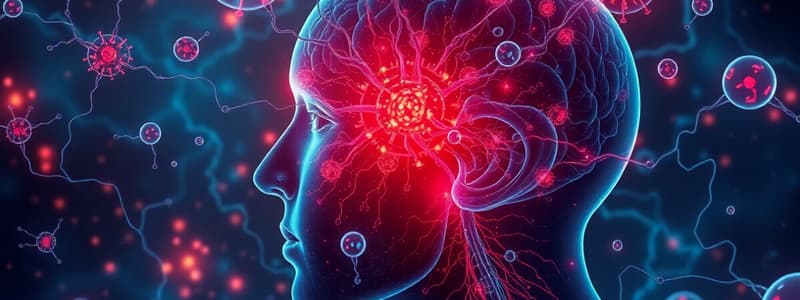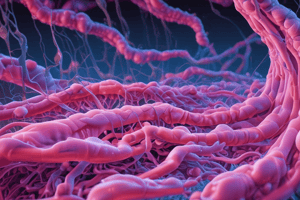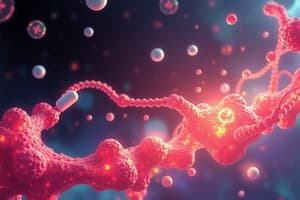Podcast
Questions and Answers
A patient taking carbamazepine (Tegretol) is exhibiting edema and increased blood pressure. Which of the following mechanisms is the MOST likely cause of these symptoms?
A patient taking carbamazepine (Tegretol) is exhibiting edema and increased blood pressure. Which of the following mechanisms is the MOST likely cause of these symptoms?
- Promotion of antidiuretic hormone (ADH) secretion leading to fluid retention. (correct)
- Decreased antidiuretic hormone (ADH) secretion causing dehydration.
- Increased potassium excretion leading to fluid retention.
- Inhibition of sodium reabsorption in the kidneys, causing fluid loss.
A patient is prescribed phenytoin (Dilantin). What common adverse effect requires diligent oral hygiene to manage?
A patient is prescribed phenytoin (Dilantin). What common adverse effect requires diligent oral hygiene to manage?
- Glossitis
- Stomatitis
- Xerostomia
- Gingival Hyperplasia (correct)
A patient who has been taking an anticonvulsant reports experiencing double vision. Which of the following adverse reactions is the MOST likely cause?
A patient who has been taking an anticonvulsant reports experiencing double vision. Which of the following adverse reactions is the MOST likely cause?
- Ataxia
- Tinnitus
- Diplopia (correct)
- Nystagmus
Why is combining anticonvulsants with alcohol particularly dangerous?
Why is combining anticonvulsants with alcohol particularly dangerous?
Which of the listed anticonvulsants is also commonly used to treat neuropathic pain?
Which of the listed anticonvulsants is also commonly used to treat neuropathic pain?
A patient is prescribed lorazepam (Ativan) before surgery. What is the PRIMARY purpose of this medication in the pre-anesthetic setting?
A patient is prescribed lorazepam (Ativan) before surgery. What is the PRIMARY purpose of this medication in the pre-anesthetic setting?
Which of the following is a potentially life-threatening adverse reaction associated with lamotrigine (Lamictal)?
Which of the following is a potentially life-threatening adverse reaction associated with lamotrigine (Lamictal)?
What is the MOST important consideration regarding anticonvulsant use during pregnancy?
What is the MOST important consideration regarding anticonvulsant use during pregnancy?
A patient with a history of bipolar disorder and seizure disorder is being treated with valproic acid. During a routine check-up, the patient reports persistent nausea, vomiting, and severe abdominal pain. Which of the following is the MOST critical initial diagnostic step?
A patient with a history of bipolar disorder and seizure disorder is being treated with valproic acid. During a routine check-up, the patient reports persistent nausea, vomiting, and severe abdominal pain. Which of the following is the MOST critical initial diagnostic step?
A pregnant patient with a pre-existing seizure disorder requires anticonvulsant therapy. Considering the teratogenic potential of many anticonvulsants, which agent, used judiciously and with appropriate monitoring, may be considered the LEAST teratogenic?
A pregnant patient with a pre-existing seizure disorder requires anticonvulsant therapy. Considering the teratogenic potential of many anticonvulsants, which agent, used judiciously and with appropriate monitoring, may be considered the LEAST teratogenic?
A patient is admitted to the emergency department experiencing status epilepticus. After administering the initial dose of diazepam, which of the following interventions is MOST critical in preventing respiratory depression and ensuring patient safety?
A patient is admitted to the emergency department experiencing status epilepticus. After administering the initial dose of diazepam, which of the following interventions is MOST critical in preventing respiratory depression and ensuring patient safety?
A patient on carbamazepine develops SIADH (syndrome of inappropriate antidiuretic hormone secretion). Beyond fluid restriction, which of the following pharmacological interventions would MOST directly address the underlying mechanism of carbamazepine-induced SIADH?
A patient on carbamazepine develops SIADH (syndrome of inappropriate antidiuretic hormone secretion). Beyond fluid restriction, which of the following pharmacological interventions would MOST directly address the underlying mechanism of carbamazepine-induced SIADH?
An elderly patient with a history of renal impairment is prescribed gabapentin for neuropathic pain. What adjustments to the dosing regimen are MOST critical to prevent adverse effects?
An elderly patient with a history of renal impairment is prescribed gabapentin for neuropathic pain. What adjustments to the dosing regimen are MOST critical to prevent adverse effects?
A patient is started on lamotrigine and develops a rash. Which clinical feature would MOST strongly suggest that the rash is progressing towards Stevens-Johnson Syndrome (SJS) or Toxic Epidermal Necrolysis (TEN), necessitating immediate discontinuation of the medication?
A patient is started on lamotrigine and develops a rash. Which clinical feature would MOST strongly suggest that the rash is progressing towards Stevens-Johnson Syndrome (SJS) or Toxic Epidermal Necrolysis (TEN), necessitating immediate discontinuation of the medication?
A patient on long-term phenytoin therapy exhibits signs of cerebellar dysfunction. Which of the following mechanisms BEST explains this adverse effect?
A patient on long-term phenytoin therapy exhibits signs of cerebellar dysfunction. Which of the following mechanisms BEST explains this adverse effect?
Which of the following laboratory findings would be MOST concerning in a patient taking carbamazepine and warrant immediate discontinuation of the drug?
Which of the following laboratory findings would be MOST concerning in a patient taking carbamazepine and warrant immediate discontinuation of the drug?
A patient with a known seizure disorder and comorbid depression is being considered for anticonvulsant therapy. Which of the following anticonvulsants may offer dual benefits, potentially addressing both conditions?
A patient with a known seizure disorder and comorbid depression is being considered for anticonvulsant therapy. Which of the following anticonvulsants may offer dual benefits, potentially addressing both conditions?
A patient who has been successfully managed on Phenobarbital for years now requires a new medication to manage severe pain. What consideration regarding drug metabolism is MOST critical when adding opioid analgesics to this patient's regimen?
A patient who has been successfully managed on Phenobarbital for years now requires a new medication to manage severe pain. What consideration regarding drug metabolism is MOST critical when adding opioid analgesics to this patient's regimen?
Flashcards
Anticonvulsant Medications
Anticonvulsant Medications
Medications used to treat seizures and certain pain disorders.
Status Epilepticus
Status Epilepticus
A medical emergency characterized by continuous seizures without interruption.
Valium
Valium
The drug of choice for treating status epilepticus, helps stop seizures.
CNS Depressant
CNS Depressant
Signup and view all the flashcards
Common Adverse Reactions of Anticonvulsants
Common Adverse Reactions of Anticonvulsants
Signup and view all the flashcards
Gingival Hyperplasia
Gingival Hyperplasia
Signup and view all the flashcards
Tegretol (Carbamazepine) Uses
Tegretol (Carbamazepine) Uses
Signup and view all the flashcards
Lyrica (Pregabalin)
Lyrica (Pregabalin)
Signup and view all the flashcards
Anticonvulsants
Anticonvulsants
Signup and view all the flashcards
Common Side Effects
Common Side Effects
Signup and view all the flashcards
Serious Adverse Reactions
Serious Adverse Reactions
Signup and view all the flashcards
Phenobarbital
Phenobarbital
Signup and view all the flashcards
Dilantin
Dilantin
Signup and view all the flashcards
Carbamazepine (Tegretol)
Carbamazepine (Tegretol)
Signup and view all the flashcards
Benzodiazepines
Benzodiazepines
Signup and view all the flashcards
Valproic Acid (Depakote)
Valproic Acid (Depakote)
Signup and view all the flashcards
Magnesium Sulfate
Magnesium Sulfate
Signup and view all the flashcards
Study Notes
Anticonvulsant Medications
- Primarily used to treat seizures of all types
- Also used for neuropathic pain, bipolar disorders, and anxiety disorders
- Valium (diazepam) is the drug of choice for status epilepticus, a medical emergency of continuous seizures
- Anticonvulsants are known as anti-epileptics and are central nervous system (CNS) depressants
- Combining anticonvulsants with other CNS depressants (like alcohol) can worsen effects
- Anticonvulsant use during pregnancy may be associated with birth defects
Adverse Reactions
- Common: Drowsiness, headache, somnolence, nystagmus (involuntary eye movements), ataxia (lack of coordination), slurred speech, diplopia (double vision), gastrointestinal issues (nausea, vomiting, diarrhea, anorexia, constipation)
- Gingival hyperplasia: Gum overgrowth, frequently seen with Dilantin (phenytoin)
- Cardiovascular: Irregular heartbeat (dysrhythmias)
- Skin: Rashes, particularly with Lamictal (lamotrigine)
- Urinary: Increased frequency
- Serious: Steven-Johnson Syndrome (serious skin reaction), pancytopenia (decrease in all blood cells), leukopenia, aplastic anemia, thrombocytopenia
Classification of Anticonvulsants
- Barbiturates: Phenobarbital
- Hydantoins: Phenytoin (Dilantin)
- Succinimides: Ethosuximide
- Sodium Channel Blockers: Carbamazepine (Tegretol)
- Benzodiazepines: Diazepam (Valium), Lorazepam (Ativan)
- Miscellaneous: Gabapentin (Neurontin), Pregabalin (Lyrica), Valproic Acid (Depakote), Topiramate (Topamax)
Additional Uses of Anticonvulsants
- Lyrica (pregabalin): Neuropathic pain, postherpetic neuralgia, anticonvulsant
- Ativan (lorazepam): Pre-anesthetic medication
- Tegretol (carbamazepine): Bipolar disorder, neuralgia, increases ADH (antidiuretic hormone) potentially leading to fluid retention, edema, and heart failure.
- Neurontin (gabapentin): Neuralgia
- Magnesium Sulfate: Seizures in eclampsia (pregnant women) and acute nephritis in children.
Additional Uses and Side Effects
- Depakote (valproic acid) and Topamax (topiramate): Migraine headaches
- Depakote (valproic acid): Mania, hepatotoxic (liver damage), pancreatitis (inflammation of the pancreas)
- Pancreatitis symptoms: Nausea, vomiting, abdominal pain
Contraindications and Interactions
- Contraindications: Phenytoin: Heart block, pregnancy, lactation; Valproic Acid: Renal impairment, pregnancy; Carbamazepine: Bone marrow depression, hepatic impairment, pregnancy.
- General Contraindication: All anticonvulsants should not be given within 14 days of monoamine oxidase inhibitors (MAOIs)
- Interactions: Antibiotics and antifungals may increase anticonvulsant effects
Studying That Suits You
Use AI to generate personalized quizzes and flashcards to suit your learning preferences.
Description
This lesson covers anticonvulsant medications, their primary use in treating seizures, and their applications for neuropathic pain, bipolar disorders, and anxiety. It highlights common and severe adverse reactions including drowsiness, cardiovascular issues and skin rashes. It also advises against combining these depressants with other CNS depressants like alcohol.




